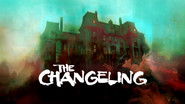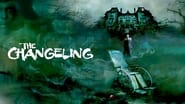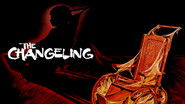Mark Turner
I remember the first time I ever saw THE CHANGELING. It was on a double bill at a drive-in and I can't recall the other feature. I was impressed with the film at the time and was stunned that it didn't do better business. It featured one of the biggest stars at the time in George C. Scott, was a horror story at a time when they were on the rise and was actually quite well done. And yet it got lost somewhere along the way. It was even rare to find a copy on a video shelf when it came out in that format. All of that changes with the release of the film in blu-ray format from Severin.Composer John Russell (Scoot) is on vacation with his wife and daughter when their car breaks down on a snow covered road. Pushing the car they come across a payphone (the movie was made when those existed) and he walks across to call for help. While he does so an oncoming car crosses the path of a truck that veers and plows across Russell's wife and daughter.Fast forward months later and Russell is still trying to cope with his loss. He moves to Seattle where a friend has set him up to teach at the local college. Looking for a place to stay an agent of the local historic society, Claire Norman (Trish Van Devere) finds him just the place, a Victorian mansion that is secluded and offers him the solace he needs. But things aren't quite what they seem. Russell begins hearing a banging every day at the same time. He has the pipes checked but the noise continues. One night when he hears water running he goes to turn it off and has a vision of a young boy drowning. As he begins investigating the history of the house he finds out more happened there than anyone has realized.Following noises in the house he finds a hidden attic. The doorway is sealed over, boarded up and shelves placed over those boards. Removing them he enters through the door and finds a room upstairs where it appears a young boy lived alone. His diary is there as well as a ball and a wheelchair he would have used. Russel continues to investigate the history of the house with the help of Claire. The noises, breaking glass in windows and more occur. He finds that the history of the house leads to a sitting Senator (Melvyn Douglas) as well as a young boy who was murdered and buried elsewhere. As he continues to discover more he still can't figure out why these images, these spectral visions are attaching themselves to him. What is it they want him to do and how can he follow through?The film is one of the best ghost stories ever committed to film. And like those that are the best it never puts everything on display for all to see. There are no floating sheets flying from one end of the house to the other, no million dollar special effects shots of walls/doors/furniture visibly changing into another form and no zombiefied corpses roaming about seeking revenge. Instead the majority of the hauntings taking place here involve the use of sound, of darkness and light and of things as simple as a bouncing child's ball to create an unsettling tale that holds the viewers interest from start to finish.Directed by acclaimed director Peter Medak who had already directed THE RULING CLASS and would go on to direct THE KRAYS, and ROMEO IS BLEEDING, the film uses a light touch rather than an in your face method of provoking scares and telling a complete story. With a combination of wonderful cinematography, a fantastic script and the acting abilities of the film's stars the result is a ghost tale that is second perhaps only to the 1963 version of THE HAUNTING, one of my all-time favorite films. The movie is an amazing film and one that I'm delighted to see saved from obscurity by Severin. It deserves it. If simply saving the film weren't enough Severin has gone the extra mile and included some wonderful extras that make you want to go back and watch the film a second time just to apply the things learned in those extras. Included in the extras are an audio commentary track with Medak, producer Joel B. Michaels and moderated by Severin Films' David Gregory, THE HOUSE ON CHEESMAN PARK: THE HAUNTING TRUE STORY OF THE CHANGELING in which we learn the facts of the actual case that the film is based on, THE MUSIC OF THE CHANGELING: AN INTERVIEW WITH MUSIC ARRANGER KENNETH WANNBERG, THE BUILDING OF THE HOUSE OF HOROR: AN INTERVIEW WITH ART DIRECTOR REUNBEN FREED, THE PSYCHOTRONIC TOURIST: THE CHANGLING which returns us to the various locations the film was shot at, Master of Horror Mick Garris talking about the film, a poster and stills gallery, the original trailer and TV spots for the film. After watching the pieces here about the real story and the construction of the sets you just want to restart it all over again.I would be remiss if I didn't mention one small item that Severin did here that deserves tremendous praise. I'm sure we've all grown weary of having to put in a disc only to sit patiently while we see the standard FBI warning about copying the film. That doesn't happen here. Instead once the disc loads on your player we see George C. Scott and Trish Van Devere sitting and looking at a microfilm machine taken from the movie. They scroll and stop and we're allowed to see what they're reading. It's the FBI warning written as a news item. What an ingenious way to insert that onto the disc! And it makes viewing the warning seem less a chore than normal, something you'll want others to see when watching the film again.Having the opportunity to watch this film again was such a joy. Having the chance to see it presented in such a way that it was clean, clear and crisp made it even more so. Previously all prints had seemed washed out and slightly off focus from seeing it on an outdoor screen to watching it on sloppily transferred video tape. Now I and many others can enjoy watching it along with the well-made extras again and again. Congratulations Severin on a job well done.
Leechpm
Sometimes a movie can have everything at its fingertips, then get its fingertips chopped off in some horrible crash. I can imagine Peter Medak as the 1970s ended and the 80s began, reflecting on how horror had developed in the previous decade, the removal of censorship twenty years ago opening the door for blood and guts to splatter all over the industry. Medak decided to turn from the new and look back on a much quieter old, directing The Changeling, a haunted house flick relying, as the tradition goes, on strange noises, unexplained occurrences, communications with the dead, and, most of all, the absence of splattering bodies.George C. Scott plays John Russell, a composer, professor, and family man who loses his wife and daughter in an auto accident. To escape their memories he moves to a new house and tries resuming his life, but strange events begin, and something in the house won't let him forget his dead family. It follows closely in the footsteps of Don't Look Now, if Don't Look Now had more genre and less sense, then butchered its own ideas.Medak handles his film with spectacle. Gothic architecture, golden walls, a large stairwell winding to a mysterious attic, and various antiques all decorate John's new home, shot beautifully with the camera floating from room to room in a never-ending pan, wide shots showing the vastness of the mansion, and later there's a shot of a well, looking first in from above, then out from below. Also, Rick Wilson composed a nice piano score. So even the film strikes its logical bottom, everything looks at least aesthetically pleasing.But as far as the plot goes, the crash is horrific, and then my heart ripped in half as the camera and John both loomed around the city, now so lonely and small. John has a counseling session, where conversation turns up some great quotes about recovery, and I truly rooted for John as he went from his compositions to his jobs, making an effort to grasp the goods in life. Then as the supernatural creeps in, the emotions go poof and never come back, no matter how many things remind John of his family. Medak attempts to juggle John's recovery with supernatural occurrences, as well as an investigation, and weaving these lines together is easy enough—after all, everything connects to John's tortured memories and difficult recovery—and yet somehow Medak manages to end one thing the second another begins and strips his story of every promise except its spookiness. John eventually isn't even the protagonists anymore, and unlike Psycho, the shift has no meaning.The scriptwriter really screws himself over by writing an emotional story about an emotionally reserved person's emotions, and then failing to give him any scenes to show his emotions, but George C. Scott does best he could have, interrupting his stone-cold, no- shits-given expression with occasional looks of vulnerability. But when the scriptwriter has John try to cast away the spirits by going to a bridge and angrily tossing a ball, there's not much Scott can do in the way of bringing some sort of continuity to the writing's madly flapping strands.Thankfully, even though The Changeling promises to elevate the genre and then disappoints, it still has enough of the horror within to hit home. Medak hides enough threats behind corners and darkness for the atmosphere to get in your belly, and the bathtub scene is terrifying. So when the ghost goes to outstanding lengths to achieve basically nothing, hints pop up of a possible possession then completely disappear, a relationship starts and never blossoms, and the most interesting character doesn't enter until we've stopped caring, at least doors hide behind bookshelves, wheelchairs come to life, and things light on fire.





